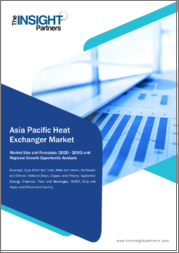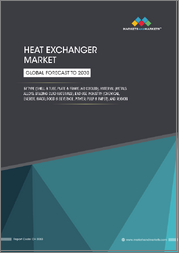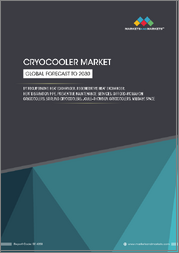
|
시장보고서
상품코드
1482003
아시아태평양의 열교환기 시장 예측(-2030년) : 지역 분석 - 유형, 재료, 용도별Asia Pacific Heat Exchanger Market Forecast to 2030 - Regional Analysis - by Type, Material, and Application |
||||||
아시아태평양의 열교환기 시장은 2022년에 45억 7,191만 달러로 평가되며, 2030년에는 92억 2,976만 달러에 달할 것으로 예측되며, 2022-2030년의 CAGR은 9.2%로 성장할 것으로 예측되고 있습니다.
3D 프린팅 기술과 열교환기의 융합이 아시아태평양의 열교환기 시장을 촉진
3D 프린팅 또는 적층 가공은 디지털 파일에서 3차원 물체를 개발하는 것입니다. 유연한 설계, 신속한 프로토타이핑, 주문형 인쇄, 가볍고 견고한 부품, 신속한 설계 및 맞춤형 생산, 폐기물 최소화, 비용 효율성, 친환경 등의 장점으로 인해 3D 프린팅 솔루션에 대한 수요가 증가하고 있습니다. 또한 친환경 솔루션의 사용과 그에 따른 온실가스 배출에 대한 전 세계적인 인식이 높아지면서 열교환기 공급업체들은 다양한 최종사용자용도 수요를 충족하는 신제품을 생산하기 위해 이 발전된 기술을 사용하도록 장려하고 있습니다. 발전 시스템, 가전제품, 식품 및 음료 제조 시설과 같은 중요한 용도에서 효율적인 열교환기에 대한 요구가 증가하면서 3D 프린팅 기술 채택에 기여하고 있습니다. 따라서 3D 프린팅 기술과 열교환기의 통합은 예측 기간 중 다양한 최종사용자용도 수요 증가에 대응하기 위해 시장 기업에게 기회를 창출할 가능성이 높습니다.
아시아태평양 열교환기 시장 개요
아시아태평양의 열교환기 시장은 호주, 중국, 일본, 인도, 한국, 말레이시아, 대만 및 기타 아시아태평양으로 분류됩니다. 시장의 성장은 중국과 인도가 주도하는 LNG 수입 확대에 크게 기인합니다. Shell LNG Outlook 2021에 따르면 전 세계 LNG 수요는 2040년까지 7억 톤에 달할 것으로 예상되며, 아시아태평양 국가들의 천연가스 수요가 강력하게 성장하여 가스 생산 수요를 창출할 것으로 예상됩니다. 발생할 것으로 예상됩니다. 인구 증가와 산업 발전에 따라 아시아태평양에서는 에너지 수요가 증가하고 있습니다. 예를 들어 IEA에 따르면 동남아시아의 에너지 수요는 2000-2020년 매년 평균 3%씩 증가하고 있습니다. 또한 2030년까지 매년 평균 5%의 성장률을 보일 것으로 예상됩니다. 이러한 수요 증가에 따라 각국 정부는 신규 정유소 도입과 기존 정유소의 생산능력 확대를 통해 석유 생산 부문을 확장하고 있습니다. 미국 에너지정보청(EIA)에 따르면 아시아와 중동에서 2030년 말까지 최소 9개의 정유소 프로젝트가 완공될 것으로 예상됩니다. 석유 생산량 증가는 플랜트 및 정유소에서 열교환기에 대한 필요성을 창출하고 이 지역 시장 성장을 더욱 촉진할 것입니다.
아시아태평양 열교환기 시장 매출 및 2030년까지의 예측(금액)
아시아태평양 열교환기 시장 세분화
아시아태평양 열교환기 시장은 유형, 재료, 용도, 국가별로 분류됩니다. 유형별로 아시아태평양 열교환기 시장은 쉘 및 튜브, 플레이트 및 프레임, 공랭식, 기타로 분류됩니다. 쉘 및 튜브 부문이 2022년 가장 큰 시장 점유율을 차지했습니다.
재료별로 아시아태평양의 열교환기 시장은 철강, 구리, 기타로 구분됩니다. 철강 부문은 2022년에 가장 큰 시장 점유율을 차지했습니다.
용도별로 아시아태평양의 열교환기 시장은 에너지, 화학, 식품 및 음료, HVACR, 펄프 및 제지, 기타로 분류됩니다. 에너지 부문이 2022년 가장 큰 시장 점유율을 차지했습니다.
국가별로 아시아태평양 열교환기 시장은 중국, 일본, 한국, 인도, 호주, 대만, 말레이시아 및 기타 아시아태평양으로 구분되며, 2022년 아시아태평양 열교환기 시장 점유율은 중국이 독식할 것으로 예상됩니다.
Alfa Laval AB, API Heat Transfer Inc, Chart Industries Inc, Danfoss AS, Guntner GmbH &Co KG, Johnson Controls International Plc, Hisaka Works Ltd, Kelvion Holding GmbH, Larsen &Toubro Ltd, Xylem Inc는 아시아태평양의 열교환기 시장에서 활동하는 주요 기업입니다.
목차
제1장 서론
제2장 주요 요약
- 주요 인사이트
- 시장의 매력
제3장 조사 방법
- 조사 범위
- 2차 조사
- 1차 조사
제4장 아시아태평양의 열교환기 시장 구도
- 에코시스템 분석
- 밸류체인의 벤더 리스트
제5장 아시아태평양의 열교환기 시장 : 주요 산업 역학
- 열교환기 시장 - 주요 산업 역학
- 시장 촉진요인
- 석유 및 가스 산업에서 열교환기의 이용
- 산업화의 진전
- 산업 용도의 급증
- 시장 억제요인
- 높은 초기 투자, 인건비, 정비
- 열교환기에 관한 안전성 우려
- 시장 기회
- 3D 프린팅 기술과 열교환기의 통합
- 전기자동차의 보급
- 향후 동향
- 열교환기 서브스크립션 모델의 도입
- 촉진요인과 억제요인의 영향
제6장 열교환기 시장 : 아시아태평양 시장 분석
- 아시아태평양의 열교환기 시장 판매고, 2022-2030년
- 아시아태평양의 열교환기 시장 예측과 분석
제7장 아시아태평양의 열교환기 시장 분석 : 유형
- 쉘·튜브
- 플레이트·프레임
- 공랭식
- 기타
제8장 아시아태평양의 열교환기 시장 분석 : 재료별
- 철강
- 구리
- 기타
제9장 아시아태평양의 열교환기 시장 분석 : 용도별
- 에너지
- 화학
- 식품 및 음료
- HVACR
- 종이·펄프
- 기타
제10장 아시아태평양의 열교환기 시장 : 국가별 분석
- 아시아태평양
- 중국
- 일본
- 한국
- 인도
- 호주
- 대만
- 기타
제11장 경쟁 구도
- 주요 기업에 의한 히트맵 분석
제12장 업계 상황
- 시장 구상
- 제품 개발
제13장 기업 개요
- Alfa Laval AB
- Kelvion Holding GmbH
- Danfoss AS
- API Heat Transfer Inc
- Chart Industries Inc
- Guntner GmbH & Co KG
- Larsen & Toubro Ltd
- Hisaka Works Ltd
- Johnson Controls International Plc
- Xylem Inc
제14장 부록
KSA 24.05.31The Asia Pacific heat exchanger market was valued at US$ 4,571.91 million in 2022 and is expected to reach US$ 9,229.76 million by 2030; it is estimated to grow at a CAGR of 9.2% from 2022 to 2030.
Integration of 3D Printing Technology with Heat Exchangers Fuel the Asia Pacific Heat Exchanger Market
3D printing or additive manufacturing is the development of a three-dimensional object from a digital file. The demand for 3D printing solutions is rising owing to advantages such as flexible design, rapid prototyping, print of demand, lightweight and robust parts, faster design and customized production, minimum waste, cost-effectiveness, and environment friendly. In addition, the rising awareness worldwide to use environment-friendly solutions and associated GHG emissions are encouraging heat exchanger providers to use this advancing technology to produce new products to meet the demand from various end user applications. The growing need for efficient heat exchangers in crucial applications such as power generation systems, consumer electronics, and food and beverage manufacturing facilities contribute to the adoption of 3D printing technology. Thus, the integration of 3D printing technology with heat exchangers is likely to create opportunities for market players to meet the growing demand from various end user applications during the forecast period.
Asia Pacific Heat Exchanger Market Overview
The Asia Pacific heat exchanger market is categorized into Australia, China, Japan, India, South Korea, Malaysia, Taiwan, and the Rest of Asia Pacific. The growing market is prominently attributed to the expansion of LNG imports led by China and India. Furthermore, the rising investment in the oil & gas industry will propel oil and gas production. As per the Shell LNG Outlook 2021, the LNG demand across the globe is expected to reach 700 million tons by 2040, and the natural gas demand is expected to grow strongly in Asia Pacific countries, generating the demand for gas production. With the rise in population and industrial growth, Asia Pacific witnessed increased energy demand. For instance, according to IEA, Southeast Asia's energy demand grew by an average of 3% every year from 2000 to 2020. It is further expected to grow by an average of 5% every year till 2030. Such a rise in demand in the region made the government expand its oil production units by introducing new refineries and expanding the production capacity of the existing oil refineries. As per the Energy Information Administration (EIA), at least nine refineries projects are expected to be completed by the end of 2030 in Asia and the Middle East. The rise in oil production generates the need for heat exchangers in the plants and refineries, which further fuels its market growth in the region.
Asia Pacific Heat Exchanger Market Revenue and Forecast to 2030 (US$ Million)
Asia Pacific Heat Exchanger Market Segmentation
The Asia Pacific heat exchanger market is segmented based on type, material, application, and country. Based on type, the Asia Pacific heat exchanger market is segmented into shell and tube, plate and frame, air cooled, and others. The shell and tube segment held the largest market share in 2022.
Based on material, the Asia Pacific heat exchanger market is segmented into steel, copper, and others. The steel segment held the largest market share in 2022.
Based on application, the Asia Pacific heat exchanger market is segmented into energy, chemical, food and beverages, HVACR, pulp and paper, and others. The energy segment held the largest market share in 2022.
Based on country, the Asia Pacific heat exchanger market is segmented into China, Japan, South Korea, India, Australia, Taiwan, Malaysia, and the Rest of Asia Pacific. China dominated the Asia Pacific heat exchanger market share in 2022.
Alfa Laval AB, API Heat Transfer Inc, Chart Industries Inc, Danfoss AS, Guntner GmbH & Co KG, Johnson Controls International Plc, Hisaka Works Ltd, Kelvion Holding GmbH, Larsen & Toubro Ltd, and Xylem Inc are some of the leading companies operating in the Asia Pacific heat exchanger market.
Table Of Contents
1. Introduction
- 1.1 The Insight Partners Research Report Guidance
- 1.2 Market Segmentation
2. Executive Summary
- 2.1 Key Insights
- 2.2 Market Attractiveness
3. Research Methodology
- 3.1 Coverage
- 3.2 Secondary Research
- 3.3 Primary Research
4. Asia Pacific Heat Exchanger Market Landscape
- 4.1 Overview
- 4.2 Ecosystem Analysis
- 4.2.1 List of Vendors in Value Chain
5. Asia Pacific Heat Exchanger Market - Key Industry Dynamics
- 5.1 Heat exchanger Market - Key Industry Dynamics
- 5.2 Market Drivers
- 5.2.1 Use of Heat Exchangers in Oil & Gas Industry
- 5.2.2 Rise in Industrialization
- 5.2.3 Surge in Industry-specific Applications
- 5.3 Market Restraints
- 5.3.1 High Initial Investment, Labor Cost, and Maintenance
- 5.3.2 Safety Concerns Regarding Heat Exchanger
- 5.4 Market Opportunities
- 5.4.1 Integration of 3D Printing Technology with Heat Exchangers
- 5.4.2 Rise in Electric Vehicle Adoption
- 5.5 Future Trends
- 5.5.1 Introduction of Heat Exchange Subscription Model
- 5.6 Impact of Drivers and Restraints:
6. Heat Exchanger Market - Asia Pacific Market Analysis
- 6.1 Asia Pacific Heat Exchanger Market Revenue (US$ Million), 2022 - 2030
- 6.2 Asia Pacific Heat Exchanger Market Forecast and Analysis
7. Asia Pacific Heat Exchanger Market Analysis - Type
- 7.1 Shell and Tube
- 7.1.1 Overview
- 7.1.2 Shell and Tube Market, Revenue and Forecast to 2030 (US$ Million)
- 7.2 Plate and Frame
- 7.2.1 overview
- 7.2.2 Plate and Frame Market, Revenue and Forecast to 2030 (US$ Million)
- 7.3 Air Cooled
- 7.3.1 Overview
- 7.3.2 Air Cooled Market Revenue and Forecast to 2030 (US$ Million)
- 7.4 Others
- 7.4.1 Overview
- 7.4.2 Others Market Revenue and Forecast to 2030 (US$ Million)
8. Asia Pacific Heat Exchanger Market Analysis - Material
- 8.1 Steel
- 8.1.1 Overview
- 8.1.2 Steel Market Revenue, and Forecast to 2030 (US$ Million)
- 8.2 Copper
- 8.2.1 Overview
- 8.2.2 Copper Market Revenue, and Forecast to 2030 (US$ Million)
- 8.3 Others
- 8.3.1 Overview
- 8.3.2 Others Market Revenue, and Forecast to 2030 (US$ Million)
9. Asia Pacific Heat Exchanger Market Analysis - Application
- 9.1 Energy
- 9.1.1 Overview
- 9.1.2 Energy Market Revenue, and Forecast to 2030 (US$ Million)
- 9.2 Chemical
- 9.2.1 Overview
- 9.2.2 Chemical Market Revenue, and Forecast to 2030 (US$ Million)
- 9.3 Food and Beverages
- 9.3.1 Overview
- 9.3.2 Food and Beverages Market Revenue, and Forecast to 2030 (US$ Million)
- 9.4 HVACR
- 9.4.1 Overview
- 9.4.2 HVACR Market Revenue, and Forecast to 2030 (US$ Million)
- 9.5 Pulp and Paper
- 9.5.1 Overview
- 9.5.2 Pulp and Paper Market Revenue, and Forecast to 2030 (US$ Million)
- 9.6 Others
- 9.6.1 Overview
- 9.6.2 Others Market Revenue, and Forecast to 2030 (US$ Million)
10. Asia Pacific Heat Exchanger Market - by Country Analysis
- 10.1 Asia Pacific
- 10.1.1 Asia Pacific Heat Exchanger Market Overview
- 10.1.2 Asia Pacific Heat Exchanger Market Revenue and Forecasts and Analysis - By Country
- 10.1.2.1 Asia Pacific Heat Exchanger Market Revenue and Forecasts and Analysis - By Country
- 10.1.2.2 China Heat exchanger Market Revenue and Forecasts to 2030 (US$ Mn)
- 10.1.2.2.1 China Heat exchanger Market Breakdown by Type
- 10.1.2.2.2 China Heat exchanger Market Breakdown by Material
- 10.1.2.2.3 China Heat exchanger Market Breakdown by Application
- 10.1.2.3 Japan Heat exchanger Market Revenue and Forecasts to 2030 (US$ Mn)
- 10.1.2.3.1 Japan Heat exchanger Market Breakdown by Type
- 10.1.2.3.2 Japan Heat exchanger Market Breakdown by Material
- 10.1.2.3.3 Japan Heat exchanger Market Breakdown by Application
- 10.1.2.4 South Korea Heat Exchanger Market Revenue and Forecasts to 2030 (US$ Mn)
- 10.1.2.4.1 South Korea Heat exchanger Market Breakdown by Type
- 10.1.2.4.2 South Korea Heat exchanger Market Breakdown by Material
- 10.1.2.4.3 South Korea Heat exchanger Market Breakdown by Application
- 10.1.2.5 India Heat exchanger Market Revenue and Forecasts to 2030 (US$ Mn)
- 10.1.2.5.1 India Heat exchanger Market Breakdown by Type
- 10.1.2.5.2 India Heat exchanger Market Breakdown by Material
- 10.1.2.5.3 India Heat exchanger Market Breakdown by Application
- 10.1.2.6 Australia Heat exchanger Market Revenue and Forecasts to 2030 (US$ Mn)
- 10.1.2.6.1 Australia Heat exchanger Market Breakdown by Type
- 10.1.2.6.2 Australia Heat exchanger Market Breakdown by Material
- 10.1.2.6.3 Australia Heat exchanger Market Breakdown by Application
- 10.1.2.7 Taiwan Heat exchanger Market Revenue and Forecasts to 2030 (US$ Mn)
- 10.1.2.7.1 Taiwan Heat exchanger Market Breakdown by Type
- 10.1.2.7.2 Taiwan Heat exchanger Market Breakdown by Material
- 10.1.2.7.3 Taiwan Heat exchanger Market Breakdown by Application
- 10.1.2.8 Malaysia Heat exchanger Market Revenue and Forecasts to 2030 (US$ Mn)
- 10.1.2.8.1 Malaysia Heat exchanger Market Breakdown by Type
- 10.1.2.8.2 Malaysia Heat exchanger Market Breakdown by Material
- 10.1.2.8.3 Malaysia Heat exchanger Market Breakdown by Application
- 10.1.2.9 Rest of Asia Pacific Heat Exchanger Market Revenue and Forecasts to 2030 (US$ Mn)
- 10.1.2.9.1 Rest of Asia Pacific Heat exchanger Market Breakdown by Type
- 10.1.2.9.2 Rest of Asia Pacific Heat exchanger Market Breakdown by Material
- 10.1.2.9.3 Rest of Asia Pacific Heat exchanger Market Breakdown by Application
11. Competitive Landscape
- 11.1 Heat Map Analysis by Key Players
12. Industry Landscape
- 12.1 Overview
- 12.2 Market Initiative
- 12.3 Product Development
13. Company Profiles
- 13.1 Alfa Laval AB
- 13.1.1 Key Facts
- 13.1.2 Business Description
- 13.1.3 Products and Services
- 13.1.4 Financial Overview
- 13.1.5 SWOT Analysis
- 13.1.6 Key Developments
- 13.2 Kelvion Holding GmbH
- 13.2.1 Key Facts
- 13.2.2 Business Description
- 13.2.3 Products and Services
- 13.2.4 Financial Overview
- 13.2.5 SWOT Analysis
- 13.2.6 Key Developments
- 13.3 Danfoss AS
- 13.3.1 Key Facts
- 13.3.2 Business Description
- 13.3.3 Products and Services
- 13.3.4 Financial Overview
- 13.3.5 SWOT Analysis
- 13.3.6 Key Developments
- 13.4 API Heat Transfer Inc
- 13.4.1 Key Facts
- 13.4.2 Business Description
- 13.4.3 Products and Services
- 13.4.4 Financial Overview
- 13.4.5 SWOT Analysis
- 13.4.6 Key Developments
- 13.5 Chart Industries Inc
- 13.5.1 Key Facts
- 13.5.2 Business Description
- 13.5.3 Products and Services
- 13.5.4 Financial Overview
- 13.5.5 SWOT Analysis
- 13.5.6 Key Developments
- 13.6 Guntner GmbH & Co KG
- 13.6.1 Key Facts
- 13.6.2 Business Description
- 13.6.3 Products and Services
- 13.6.4 Financial Overview
- 13.6.5 SWOT Analysis
- 13.6.6 Key Developments
- 13.7 Larsen & Toubro Ltd
- 13.7.1 Key Facts
- 13.7.2 Business Description
- 13.7.3 Products and Services
- 13.7.4 Financial Overview
- 13.7.5 SWOT Analysis
- 13.7.6 Key Developments
- 13.8 Hisaka Works Ltd
- 13.8.1 Key Facts
- 13.8.2 Business Description
- 13.8.3 Products and Services
- 13.8.4 Financial Overview
- 13.8.5 SWOT Analysis
- 13.8.6 Key Developments
- 13.9 Johnson Controls International Plc
- 13.9.1 Key Facts
- 13.9.2 Business Description
- 13.9.3 Products and Services
- 13.9.4 Financial Overview
- 13.9.5 SWOT Analysis
- 13.9.6 Key Developments
- 13.10 Xylem Inc
- 13.10.1 Key Facts
- 13.10.2 Business Description
- 13.10.3 Products and Services
- 13.10.4 Financial Overview
- 13.10.5 SWOT Analysis
- 13.10.6 Key Developments
14. Appendix
- 14.1 About The Insight Partners
- 14.2 Word Index



















